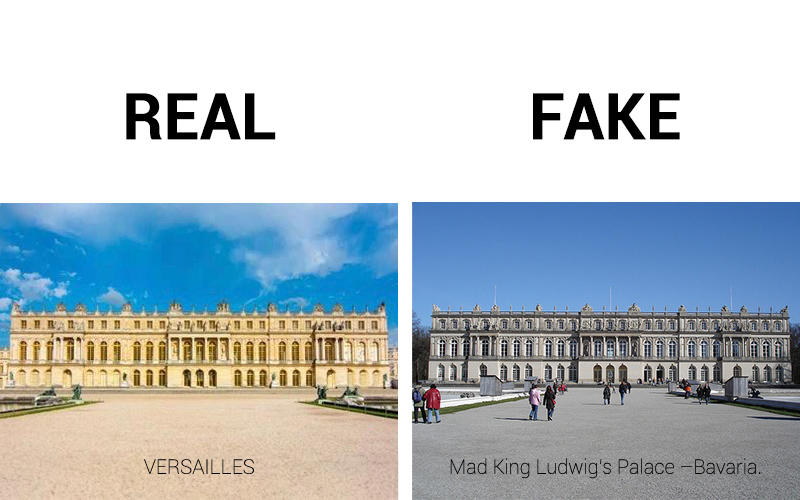Around the World – from Versailles
In June I participated in the 25th anniversary of the American Friends of Versailles –

at Versailles. It’s no secret, I am American and I’ve been a friend of Versailles for almost 50 years since my parents first introduced me to my lifelong friendship. However, last month was the first time I was feted at a banquet at Versailles’ Grand Trianon and treated like a king .
When European royalty and rulers visited Versailles starting in the late 17th century, they were inspired to copy Versailles – at once a symbol of power and elegance. Much has been written about palaces around the world that were inspired by the Palace of Versailles or, rather, the palaces of Versailles – since Versailles comprises three palaces – the grand, main palace, the smaller Grand Trianon Palace and smallest – the Petit Trianon. However, taking a closer look at Versailles’ main palace – it’s almost as if Versailles has four palaces: the Petit Trianon, the Grand Trianon and the main palace, which actually comprises two joined palaces – the early 17th-century Louis XIII red brick palace with its façade facing the city – and the late 17th-century limestone palace with its façade facing the garden in the rear.
There have been many articles, and even many books, written about the influence that Versailles’ main palace had on the history of palace design. In most of those articles the palaces resemble Versailles in only one essential aspect – size. When you look at many of the palaces that were supposedly “inspired” by Versailles, you’ll see their actual buildings don’t at all resemble Versailles’s main palace – either façade.
Only one royal visitor to Versailles was mad about the actual grand design of Versailles’ main palace’s garden facade. But then he was deemed “mad” in general – Bavaria’s “Mad King Ludwig,” who exactly copied Versailles’ Garden façade window for window, King Ludwig’s Herrenchiemsee Palace. Mad King Ludwig’s smaller palace, Linderhof, was an interpretation of Versailles’ Petit Trianon.
Let’s first examine what makes Versailles so special beyond the actual building. Versailles isn’t just a palace. Besides actually being several palaces, Versailles is especially renowned for its fountains in its exquisite expansive gardens set around a Grand Canal disappearing into the horizon. And all that is set within a very early planned city around it. In fact, one could even say Versailles is “a state of mind” – and a state unto itself.
Versailles’ French Formal Garden
The Gardens of Versailles are the epitome of the French Formal Garden created by Louis XIV’s master gardener, Andre Le Notre, who created the magnificent garden around a Grand Canal disappearing into the horizon. French Formal Gardens were flowers and trimmed boxwoods, many even trimmed into topiaries. Boxwoods and flowers are cut and planted forming symmetric designs. The resulting designs consisted of major patterns such as the Fleur de Lys. A group of these garden designs became known as a parterre.
It is Versailles’ French Formal Garden that had the most design impact, not Versailles’ Grand Palace design itself. Great Britain copied French Formal Gardens. Much is written about England’s royal palace, Hampton Court, being a copy of Versailles. The formal gardens of the Wren Building are in the style of Versailles, complete with fountains.
Versailles’ English Garden
In the late 18th century, Versailles also introduced to France yet another type of garden – the English Garden, which gives the impression of a “natural” garden with boulders around ponds and lakes, and paths meandering through hills. However, here’s the irony – frequently, “natural” style English Gardens entail much more work than French Formal Gardens, moving in boulders, blocking up streams to create artificial lakes and piling dirt to form artificial hills, etc.
Versailles has the best of both garden styles. In fact, the smallest palace, the Petit Trianon, has a French Formal Garden, with fountain, in front – and an English Garden in the rear that leads to Marie Antoinette’s Hamlet.
Versailles’ Grand Canal
At Versailles, Louis XIV’s garden architect and designer, Andre Le Notre, perfected the design of earlier grand canals.
Symmetrical gardens balance both sides of the Grand Canal as well as fountains leading the way to a focal point . The horizon paths along the canal are lined with statues. Some intersecting paths veer off and lead the way to hidden gardens in delightful groves.
Grand canals with French Formal Gardens most like Versailles are found at the palaces of Caserta, La Granja, Peterhof and two royal palaces in one city – Munich – Nymphenburg and Schleissheim Palace.
Versailles – The Ballroom Grove – Cascading Fountain
Another type of garden combined with fountains was created at Versailles and widely copied in its groovy groves (“bosquet” is “grove” in French), which are gardens hidden within a conglomeration of trees – so that when visitors enter the grove, different fountains surprise, entertain and delight them. Versailles’ Ballroom Grove, Andre Le Notre’s final grove design, is composed of a semi-circular fountain with water starting at the top of and then cascading down many flights of stairs. In the late 1990s Paris’ newly created Parc de Bercy literally copied Versailles’ Cascading Fountain almost step for step with water actually cascading down Bercy’s steps.”
Versailles and the Planned City
From Versailles’ city façade there’s a “trident” – three avenues leading from Versailles straight to Paris — in the form of three prongs on a “trident.”
It’s the consensus that Le Notre is the greatest gardener of the 17th century. When Le Notre’s Versailles gardens are mapped out, you can actually perceive the greatness – straight paths leading out from rotaries – long vistas with different focal points intersecting. While Versailles’ main palace has had some effect on subsequent palace design, its main influence was on garden design and city planning. Such as in creating our nation’s capital, Washington, DC.
For the full version of this article, please go to: www.jaxfaxmagazine.com/been-there-havent-done-that/




